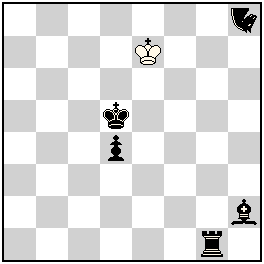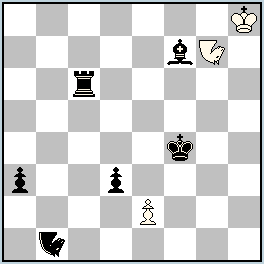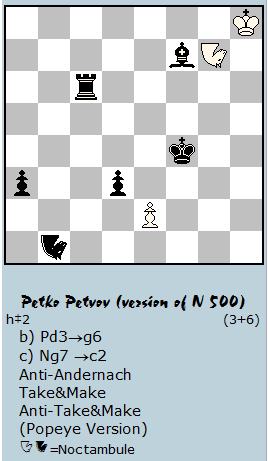|
No.500 No.500.1 |
Original Problems, Julia’s Fairies – 2014 (I): January – April →Previous ; →Next ; →List 2014(I) Please send your original fairy problems to: julia@juliasfairies.com |
 No.500 by Julia Vysotska – A miniature with three dynamic fairy conditions! For now, technically it is the most complicated problem I have. I believe it’s a miracle that I’ve found this one after all tries! And the same time I hardly believe that this is the 500th time when I publish a problem! I really want to congratulate myself! And the site, and all of you!
No.500 by Julia Vysotska – A miniature with three dynamic fairy conditions! For now, technically it is the most complicated problem I have. I believe it’s a miracle that I’ve found this one after all tries! And the same time I hardly believe that this is the 500th time when I publish a problem! I really want to congratulate myself! And the site, and all of you!
Note: This problem is C+ by Popeye, but has just one solution by WinChloe, because the move order for combination of conditions Take&Make and Anti-Take&Make is different in the both programs. Popeye considers that Take&Make works first, and Anti-Take&Make – after that. (JV)
No.500.1 by Julia Vysotska & Petko A. Petkov – A three-solution version of No.500, full cycle!! I believe that the both – my idea and your comments – encouraged Mr.Petkov to achieve this beautiful position! (JV)
Definitions:
Anti-Andernach: A piece (excluding King) changes its color after any non-capturing move. After capture, the piece retains its color. Rooks on a1, h1, a8 and h8 can be used for castling, provided the usual other rules for that move are satisfied. After castling, Rooks do not change color. If White makes a non-capturing move with neutral or halfneutral piece, that piece becomes black and vice versa.
Take & Make: Having captured, a unit must immediately, as part of its move, play a non-capturing move in imitation of the captured unit from the capture-square. If no such move is available, the capture is illegal. Promotion by capture occurs only when a pawn arrives on the promotion rank as the result of a take&make move. Checks are as in normal chess: after the notional capture of the checked K, the checking unit does not move away from the King’s square.
Anti-Take & Make: Every capture (“take”) must be complemented by a further step (“make” which is not a capture) by the captured piece (Kings excluded), which must move from its square of vanish (according to the wishes of the capturing side in case of options). The capture is forbidden if the captured unit has no possible moves. Promotions at the end of the “make” element are normal.
Nightrider(N): (1,2) Rider. Operates along straight lines with squares lying a Knight`s move away from each other.
|
No.500 Julia Vysotska
Latvia
original – 14.02.2014
 h#2 2 solutions (1+5) h#2 2 solutions (1+5)Anti-Andernach Take&Make Anti-Take&Make Nightrider h8 (Popeye version) Solutions: (click to show/hide)
|
No.500.1 Julia Vysotska & Petko A. Petkov
Latvia / Bulgaria
Version of No.500 – 01.03.2014
 h#2 b) Pd3→g6; c) Ng7→c2 (3+6) h#2 b) Pd3→g6; c) Ng7→c2 (3+6)Anti-Andernach Take&Make Anti-Take&Make Nightrider b1, g7 (Popeye version) Solutions: (click to show/hide)
|



An excellent synthesis of three difficult fairy conditions ! The play is dynamic, beautiful and unusual – the solutions start from a curious “White -Minimal” position constructed with only six figures! Congratulations, Julia!
This wonderful and unusual cycle of pieces with only 1 additional bP on the board and both solutions ending in ideal mates really deserves the jubilee number! Congrats to you for both achievements!
In the following setting Black’s first moves are “tempo” moves, played purely to change the piece’s colour!
stipulation h#2
Pieces
White Ke7
Black Kd5 Rb4 Bc4 Ne3 Pd4
Condition Take&Make CirceTake&Make AntiAndernach
1.Ne3-g2=w Ng2*c4-a2[+bBd3] 2.Rb4-b3=w Rb3*d3-f5[+bBc4]#
1.Rb4-a4=w Ra4*c4-b3[+bBd3] 2.Ne3-a5=w Rb3*d3-b5[+bBe4]#
C+ Popeye 4.65 and WinChloe 3.24
Dear Petko and Manfred, thanks a lot, I’m so happy to hear your words!
Dear Geoff, thank you for your version! Honestly, I’m not sure either a move played purely to change a piece’s color is more valuable.. In general, myself I like several effects of the one move, although I might be wrong in my preferences (Would be interesting to hear other views!). That’s why I’ve started to enjoy the combinations of dynamic fairy conditions.
On another hand, it’s interesting when a piece has to be moved somewhere while it is already on the “right” place for the second move!! (Are these moves really tempo?)
So, I like your idea, but there’re several weaknesses in your version:
1) half of mating move is the same in the both solutions and I’d really prefer the 2nd move of the 2nd solution to be made by N!
2) the 1st anti-take&make move [+bBd3] is the same in the both solutions.
Good analysis Julia! Your problem is very nice with everything changing so fast, that is was not easy to follow from the diagram ! Well I think that is what is meant by ‘dynamic’ play. Keep it up !
I think there is a deep question in this. You can say there are two broad groups of chess problem ideas: those where the point is in what happens on the boad, and those where the point is in why those moves are being played. (Compare to spectacular sacrifices vs subtle manoeuvering in OTB play.) The distinction is not always clearcut and of course there are problems that fit in both groups, but generally I think this is a useful classification.
In a “strategic” problem, i.e. one of the “Why?” type, the reasons for the moves is central feature and it would be a serious flaw if a move that should be played for reason A is also forced by reason B (“impurity of aim”). To have a black piece move solely for the reason of changing its colour, and not also for reaching another square or something similar, would be an interesting effect in this style of composition (but much more is needed to make a good problem out of it).
Julia’s problem is clearly of the other kind. For example, Bxh8 is the only way for the B to reach b5 on W2, but the move is also necessary to put the bN on d6 without wasting a half-move – so the point is not in why the move is played.
In general, you can’t say that one style is better than the other. But this case, the composer’s version is obviously much superior to the proposed version with more clearcut motivations.
Kjell has a deep point. I would add the following:
The “why people” are more frequent in direct play, especially orthodox n-mates. This has two reasons
1.Tradition : There is a tradition for more than 100 years to look for deep and interesting reasons of play in chess problems, especially in German speaking countries.
2. Problem genre: In direct play we stage a kind of fight on our little board. Not only the sucessful line is important. It is liked that there are almost sucessful attacks which are refuted by interesting play of black (tries). Only in the solution it is possible to overcome black’s activity. So the tries are substancial for the value of the play. The main interest lies in the difference between try and solution. This is similar in a tennis game: It is most interesting if the winner makes the point by cunning returns to a very good defence. Even without tries the principle is active in the defences to the threat:
the defenceive motives are very important, in some respect tries are unavoidable because after
the defence one can try to play the threat. This kind of thinking is not possible in helpgames. Unsufficient moves simply do not lead to mate without any activity by black. So in helpmates etc. one has to express quality by other means.
Kjell’s point goes after the fundaments of the ideas. Unfortunately, it might be misinterpreted.
The following reasoning is very far from being precise and clear and requires rather creative personal interpretation. And that’s my intention, to draw attention to some basic points which might be differently interpreted.
Chess problem is a certain position with a certain stipulation. Stipulation indicates the existance of unique play leading to one or more final positions in which the stipulation will be fulfilled. In these positions the relevant pieces will execute certain functions/effects, relevant for that fulfillment (for instance, the flights will be prevented by guard/block and the checking piece/line must be unaffected).
These final effects do not make the idea or thematic content, they are just the intrinsic tools of the stipulation. And the stipulation serves only as a “trigger” for the play which will show more effects and features than those needed in the very end. The idea is not WHAT and WHY should be played to achieve directly the final effects, the original idea opens a new dimension. WHAT and WHY happens in that dimension is a thematic content of a chess composition. Mere “stipulated positions” may be “self-sufficient” for solving training in a “result-dimension”, but a chess problem creates some original idea in an “abstract dimension”.
A mere trivial flightguard, although pure, can hardly be thematic. But some additional effect might be thematic. Of course, that additional thematic effect would not show a full purity of aim (due to the trivial unguard). Purity of aim greatly depends on the specificity of a particular idea. A good mechanism can achieve a convincing relative purity of aim, this is naturally present in many good helpmates. Insisting on the purity of aim in helpmates often shows trivial “result”-purity, or terribly non-economic mechanisms for achieving some “abstract” purity.
Dynamics with antagonistic tension of the “abstract dimension” comes out of precise avoiding or compensating for the harmful/defensive effects which would occur together with the useful effects.
A play which directly and merely serves for establishing the final effects shows only the “result-dimension” but the delicate relations and balance of the pieces in the mechanism can reveal the “abstract dimension”.
Julia’s No.500 shows the “abstract” dynamics and balance of the highly economic mechanism. The combined conditions make this task very complex. Incomplete cycle is quite a great achievement with perfect economy, including beautiful ideal mates. Complete cycle would increase the complexity of the mechanism to a fantastic level, but only if the twinning would leave the pieces of the mechanism on their diagram positions. Changes in the mechanism might greatly diminish the delicate relation with the combined conditions.
However, I don’t give much to the trivially motivated “dynamic play” which directly comes out of the dynamic and combined rules. The truly original dynamics of No.500 is in the transferred utilization of the conditions, combined with the transferred functions of the moves (from piece to piece). R/N change color and capture each other for T&M and AntiT&M effects. But the functions are different, mate/block by R and block/guard by N. Functions of mate/guard are transferred to B as the links for closing the cycle. Thus the motivations, trivially required by the stipulation, reveal their dynamic significance in the “abstract dimension” of the mechanism.
“White minimal” is true only if we consider the diagram as a picture. But considering the content of chess problem, it’s anything but true. It actually downgrades the value of true minimals -(
Everything is indeed changing fast, and the three thematic pieces all play major parts in each solution, so everyone assumes this must be somehow cyclic, but is it really?
Yes it is!
If we denote complex functions by letters like this;
A = move on B1, capture on W1 to take up a guarding position;
B = move on B2, captue on W2 to take up a mating position;
C = captured on W1 to take up another position, captured on W2 to take up a blocking position;
then Black’s B/R/N perform the functions ABC in solution I, and the functions BCA in solution II.
So, a perfect cycle with quite complex elements! Now I understand why Julia spoke about the most complicated problem she had.
I am sorry. I feel that it is not full cycle. A full cycle must be A/B/C, B/C/A & C/A/B with 3 solutions (or 3 phases) where in the first solution/1st phase, function A is performed by a piece X, function B is performed by a piece Y & function C is performed by a piece Z. In the second solution/second phase, X performs B, Y performs C & Z performs A and in the third solution/third phase X performs C, Y performs A and Z performs B. I would like to be corrected if I am wrong.
The very first day when I saw this problem, it impressed me very much and I though a full cyclic play must be possible and it is still haunting my brain. May be it is possible in 3 phases or it might be possible by using fairy pieces for R/B/N.
“Cyclic” need not be full. Full cycle is one possible aspect of cyclic change of functions. I am sure if Bala tries he can find a way to complete the cycle 🙂
Thank you, Kjell, for the both comments! You made me think a lot! Composing this problem I considered there’s an interesting sequence of change of functions of 3 active pieces. Your presentation showing a cyclic play with letters for functions is very interesting and convincing! The only thing, in your case the second solution would be CAB; or functions for B & C should be exchanged to get ABC for B/N/R in the 1st solution and BCA for the 2nd solution.
If this is a cycle?
While I was thinking what is a cycle and what is not, Bala’s and Seetharaman’s comments came.. And now it seems more clear: so, I have a cyclic play, but don’t have a full cycle, right?
I agree with Bala that 3 solutions might be very interesting here, but the same time even 2 solutions were not easy to compose. And the benefits of this version are miniature form and ideal mates. 3 solutions (if possible) would require more material and maybe twins as well… and a co-author in my case! 🙂
>> and a co-author in my case! 🙂
tell me how much latvian chocolates you’ll give.. 😉
(I’m glad my remarks were of some interest :-))
Yes, your pattern ABC-BCA is a real cycle, mathematically speaking the same kind of cycle as in the classic Lacný theme. (ABC-CAB is actually just another way of writing the same cycle, and AB-BC-CA is yet another way of writing that cycle – it just depends on from what direction you look at the play).
When you write a cycle out in letters, you have to decide what should decide the order of the letters in each part of the chain (for example, in the Lacný theme you have to decide in which order the thematic defences should be given). In this case, I arbitrarily chose to have first the function of the B, then the function of the R, and then the function of the N. With that ordering principle, solution I becomes ABC and solution II does become BCA as I wrote (for example, in solution II the bishop moves on B2 and captures on W2, which is my function B, so the first letter is a B, etc).
What letters and what ordering principle to use is not fundamental: if you do it correctly, the cycle will always appear. It has to appear: when three pieces perform the same three functions in two lines, and no piece repeats its function, the arrangement must be cyclic.
Yes, there are complete cycles ABC-BCA-CAB, and of course the problem would be greater still if there were a third solution with the functions CAB (in my notation). But it would be a miracle if that were possible here – I bet not even Shankar Ram doped by Latvian chocolate can do it, without losing most of the elegance of Julia´s position and play.
Hello, Kjell..!
The latvian chocolates were just a joke, of course.. wanted to lighten the discussion a bit.. which seemed to be getting too lengthy and heavy..
Maybe I wouldn’t bet on myself either..! 😉
But I do feel, like others, that the complete cycle is doable.. maybe not in Julia’s existing matrix.. but with a different position.. and with twinning..
Perhaps, somebody is already close to doing it..!
If not, a “composing challenge” or TT maybe in order..
“Julia’s theme”..? 🙂
When the first and the last links of a chain are connected, chain is closed into a circle/cycle. In ABC+BCA, C and A are linked and there’a a circle. This cycle is incomplete, but the essential difference between an incomplete and a complete cycle requires long explanation.
Dear Seetharaman,
In fact I tried to have cyclic play but could not succeed. I think most probably it can’t be a 3 solution but should be a 3 phase problem. As Julia said it seems to be really a very difficult task to get a full cycle.
Twin setting should be a perfectly acceptable option.
I offer a version of Julia’s No.500 – here is a full threefold cyclic interchange of functions between the black thematic pieces: Rook, Nightrider, Bishop. Model mates!! I’ve also a lot of analogical versions with 3 solutions but this position seems to be the most successful because there are 3 very beautiful solutions in my opinion. I think that here the w.Ng7 is not a weakness because this piece keeps 2 squares around the black King and it is also in a harmony with a fairy material used here! If Julia wishes, we can publish this problem as a co-work!
“Popeye version” here means that the combination Take&Make +Anti-Take&Make is realized accordingly to Popeye’s implementation.
[img [/img]
[/img]
a) 1.Nb1-e7=w Ne7*c6-c3[+bRg6] 2.Bf7-e8=w Be8*g6-d6[+bRg4] #
b) 1.Bf7-a2=w Ba2*b1-h4[+bNf3] 2.Rc6-c3=w Rc3*f3-d4[+bNe5] #
c) 1.Rc6-c7=w Rc7*f7-d5[+bBg6] 2.Nb1-h4=w Nh4*g6-h5[+bBe4] #
(C+ Popeye 4,65)
Great innovation Petkov.. beautiful mates and a complete cycle. Perfect finish for a wonderful effort by Julia!
Oh, God, I couldn’t believe it is possible, and I still hardly believe it is done! Sometimes when my problems are improved, I think “how can’t I find it myself?!”. But this is not such case. I had many diagrams with possible mating positions for different solutions printed out, written notes about possible positions of the 3 pieces, and still it was a complicated task for me to join even two of the solutions in one problem! So, I didn’t dream about the 3rd one.
Dear Petko, thank you very much for your efforts and a wonderful problem! Of course, it will be a pleasure for me to have this great work as a joint with you!
That is the different between a talented composer and the champion Petkov. 🙂
Great..! I said somebody would do it.. didn’t i..?
GM Petkov.. you da man..
And with beautiful model mates too.. (what’s that..? no ideal mates..? well.. this ain’t an ideal world, no..? :-))
Sheer cyclic heaven..
wNg7 (not d1..) a weakness..? No way..!
Congratulations to both authors for a wonderful conclusion..
[img]https://db.tt/s3ZbSfgu[/img]
created a gif of the final positions..
couldn’t resist..!
Nice presentation, Shankar Ram!! You made me read about animated gifts 🙂
[img]https://db.tt/Ggm5kwLk[/img]
Here’s a more complete one..!
[img]https://db.tt/cE6U7Xyu[/img]
..and a final(? ;-)) version with moves..
It was very funny. I was totally unaware that Mr. Petko had already made the full cycle version. Only today I mailed the following version (with numerous cooks!!) to Seetharaman asking him whether he could further work on it.
wh: Ka5 Pc4 Bl: Kc5 Re6 Bh5 Nh2
1.Bg3(=w) Bxh2-f6(+Nb5) 2.Rb6(=w) Rxb5-c7(+Nd6)#
1.Nd4(=w) Nxe6-e8(+Rf6) 2.Bg5(=w) Bxf6-f2(+Rc6)#
1.Rf5(=w) Rxh5-f6(+Bf2) 2.Ng4(=w) Nxf2-e1(+Bd4)#
Of course, I did not bother about duals as there were already so many cooks. Only thing I hoped was if I work with someone else jointly it might be possible to make the idea sound.
When I sent this unsound version to Seetharaman & called him on phone he said that Mr. Petko has already done a beautiful version showing the full cycle!
Now I am really very happy that a good version has emerged at last. Hats off to Mr. Petko! It is remarkable that he achieved this difficult task in such a short period.
This really is a beautiful problem. I haven’t wanted to comment on this until now in order to take the time to truly fathom all that goes on here. Julia-you really did your homework here. There are a tremendous amount of effects that go on, and to look for all those possible mating positions and then focus on the 2 original ones you had took a lot of work. How Petko was able to find a thematic third solution so quickly is beyond me! Congratulations to both of you! The fairy stipulation and the use of the nightrider throughout is quite excellent!
ad 500)
http://pdb.dieschwalbe.de/search.jsp?expression=PROBID=%27P1312932%27